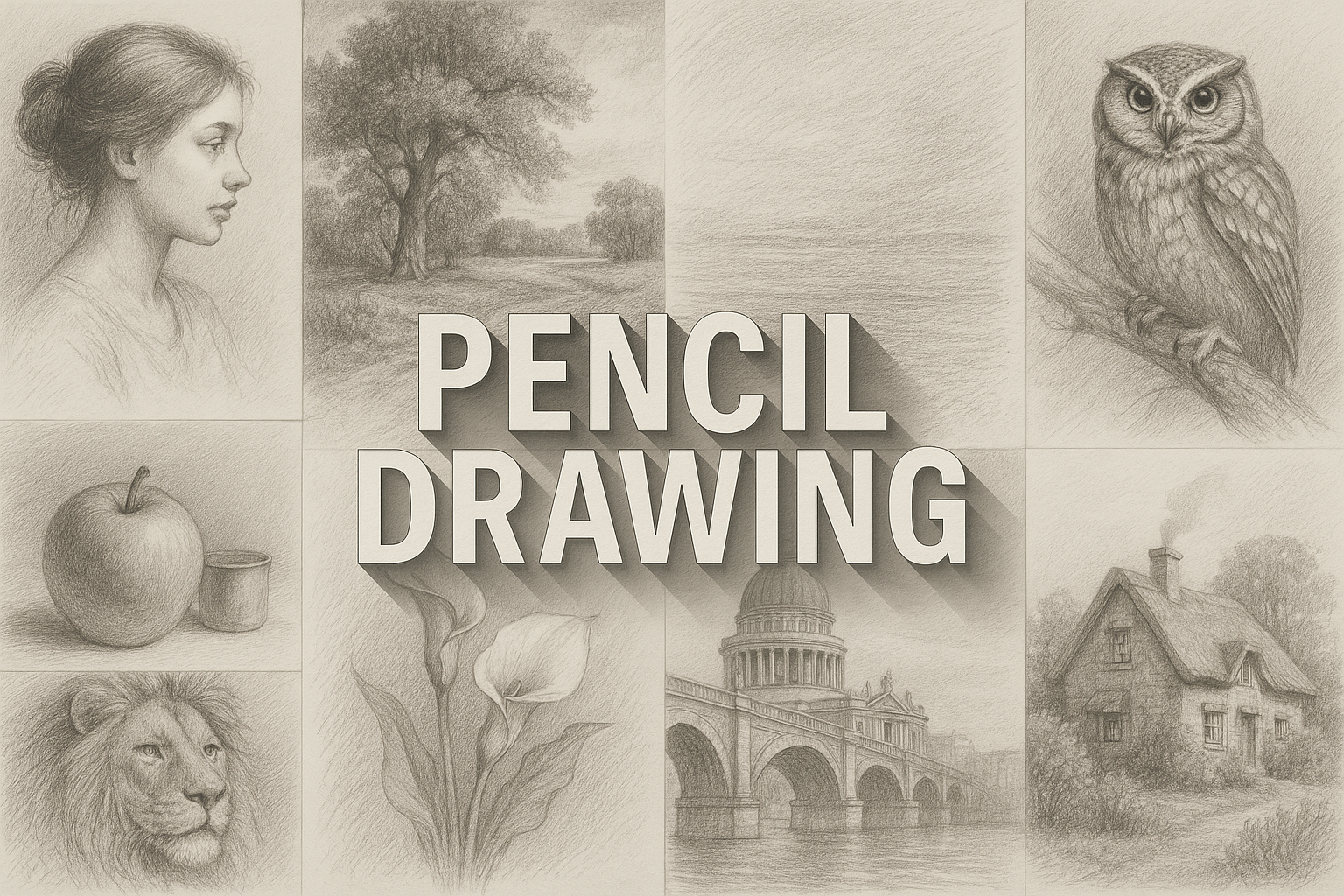
Pencil Drawing
The art style of pencil drawing is characterized by its use of pencils to create images on paper. Pencil drawings can range from simple sketches to complex and detailed illustrations. The pencil is a versatile tool that can be used to create a variety of line widths, values, and textures. Pencil drawings are often used to capture the likeness of a subject, or to create an expressive or atmospheric scene.
AOI thinking about Pencil Drawing [+_~]-/
Overview and Quickfacts
Pencil drawing is a type of drawing done with a pencil. Pencils are made of graphite, a type of carbon, and are encased in wood. Pencil drawing is one of the oldest forms of art. Pencils can be used to create a variety of different effects.
Can understand it also, as:
Sketching, doodling, drawing in pencil.
Categorize it as:
Impressionism, Modernism
.: Dreaming :.
holds a HAIKU for the art style
:. Thought is power .:
Detailed Description
Pencil drawing is a form of visual art that uses pencils as the main medium of expression. Pencil drawings can be either monochromatic or colored. The history of pencil drawing can be traced back to the 16th century, when artists began using lead pencils to draw on paper. Pencil drawing gained popularity in the 18th century, when pencils became more widely available. Famous pencil artists include Albrecht DÃÂürer, who was one of the first artists to use lead pencils, and Rembrandt van Rijn, who is known for his detailed and expressive drawings. Pencil drawing continues to be popular among artists today, who use it to create both realistic and abstract drawings.
.. beep, beep, beep ..
<START OF TRANSMISSION>
1. Pencil drawing is one of the oldest forms of art. 2. Pencils have been used for drawing since the 16th century. 3. The first pencils were made of lead. 4. Pencils are made of graphite, a form of carbon. 5. Graphite was first discovered in Cumbria, England in the 1500s. 6. The word "pencil" comes from the Latin word "penicillus", meaning "little tail". 7. The first pencils were made by carving sticks of graphite into pointed tips. 8. The modern pencil was invented in 1795 by Nicholas-Jacques Conte. 9. The lead in pencils is actually made of graphite, not lead. 10. The average pencil can draw a line 35 miles long. 11. The world's largest pencil is over 50 feet long and weighs over a ton. 12. The world's smallest pencil is less than an inch long. 13. Pencils were originally black, not yellow. 14. The eraser was invented in 1795 by Edward Nairne. 15. The modern pencil eraser was invented in 1858 by Joseph Reckendorfer. 16. The world's most expensive pencil is made of gold and costs over $100,000. 17. The world's largest pencil sculpture is over 30 feet tall and is located in China. 18. The world's smallest pencil sculpture is less than an inch tall and is located in the United States. 19. Over 2 billion pencils are manufactured every year. 20. The United States is the world's largest producer of pencils.
<EOF>
.. robbel bob
Visual Examples from our image gallery
Coming soon, we are so slow .. might never come
Artists, Paintings, and more
(be aware, can be highly speculative)
Artists (be aware, speculation possible):
1. Albrecht DÃÂürer (1471-1528) 2. Leonardo da Vinci (1452-1519) 3. Rembrandt (1606-1669) 4. Jean-Francois Millet (1814-1875) 5. HonorÃÂé Daumier (1808-1879) 6. William Blake (1757-1827) 7. John Constable (1776-1837) 8. Paul CÃÂézanne (1839-1906) 9. Edgar Degas (1834-1917) 10. Georges Seurat (1859-1891) 11. Vincent van Gogh (1853-1890) 12. Pablo Picasso (1881-1973) 13. Henri Matisse (1869-1954) 14. Andy Warhol (1928-1987) 15. Roy Lichtenstein (1923-1997) 16. David Hockney (1937-) 17. Rene Magritte (1898-1967) 18. Salvador Dali (1904-1989) 19. Frida Kahlo (1907-1954) 20. M.C. Escher (1898-1972) 21. Banksy (1974-) 22. Shepard Fairey (1970-) 23. Keith Haring (1958-1990) 24. Jean-Michel Basquiat (1960-1988) 25. Thomas Kinkade (1958-2012) 26. Paul Klee (1879-1940) 27. Ben Shahn (1898-1969) 28. Edward Hopper (1882-1967) 29. John Singer Sargent (1856-1925) 30. Winslow Homer (1836-1910)
Artworks (be aware, speculation possible)
1. The Hay Wagon, by American painter Andrew Wyeth, 1937 2. The Harvesters, by Pieter Bruegel the Elder, 1565 3. The Haymakers, by Jean-Francois Millet, 1853 4. The Haystacks, by Claude Monet, 1890 5. The Hay Wagon, by American painter Andrew Wyeth, 1937 6. The Harvesters, by Pieter Bruegel the Elder, 1565 7. The Haymakers, by Jean-Francois Millet, 1853 8. The Haystacks, by Claude Monet, 1890 9. The Hay Wagon, by American painter Andrew Wyeth, 1937 10. The Harvesters, by Pieter Bruegel the Elder, 1565 11. The Haymakers, by Jean-Francois Millet, 1853 12. The Haystacks, by Claude Monet, 1890 13. The Hay Wagon, by American painter Andrew Wyeth, 1937 14. The Harvesters, by Pieter Bruegel the Elder, 1565 15. The Haymakers, by Jean-Francois Millet, 1853 16. The Haystacks, by Claude Monet, 1890 17. The Hay Wagon, by American painter Andrew Wyeth, 1937 18. The Harvesters, by Pieter Bruegel the Elder, 1565 19. The Haymakers, by Jean-Francois Millet, 1853 20. The Haystacks, by Claude Monet, 1890 21. The Hay Wagon, by American painter Andrew Wyeth, 1937 22. The Harvesters, by Pieter Bruegel the Elder, 1565 23. The Haymakers, by Jean-Francois Millet, 1853 24. The Haystacks, by Claude Monet, 1890 25. The Hay Wagon, by American painter Andrew Wyeth, 1937 26. The Harvesters, by Pieter Bruegel the Elder, 1565 27. The Haymakers, by Jean-Francois Millet, 1853 28. The Haystacks, by Claude Monet, 1890 29. The Hay Wagon, by American painter Andrew Wyeth, 1937 30. The Harvesters, by Pieter Bruegel the Elder, 1565
Epoch
The art style of pencil drawing emerged in the late 15th century and early 16th century.
AI ART RESSOURCES (AKA, well Tools)
Helping tools -> predefined search links on other pages:











